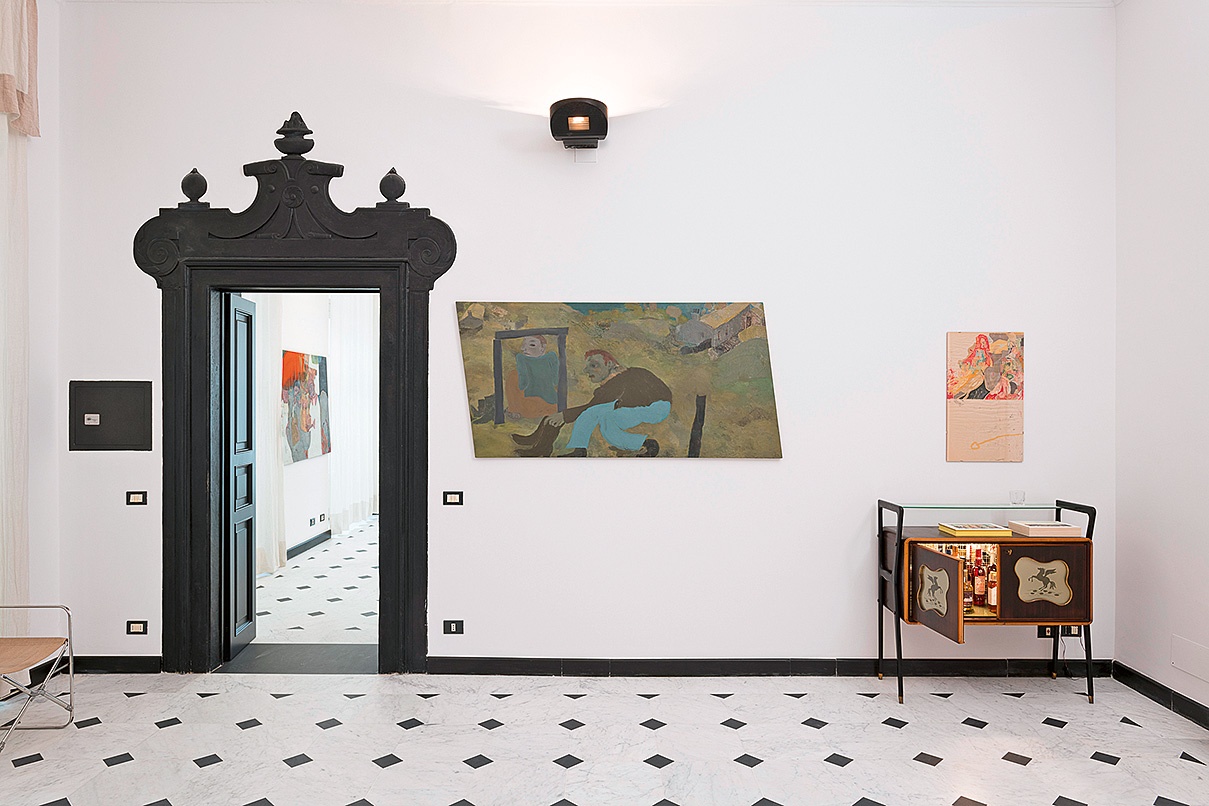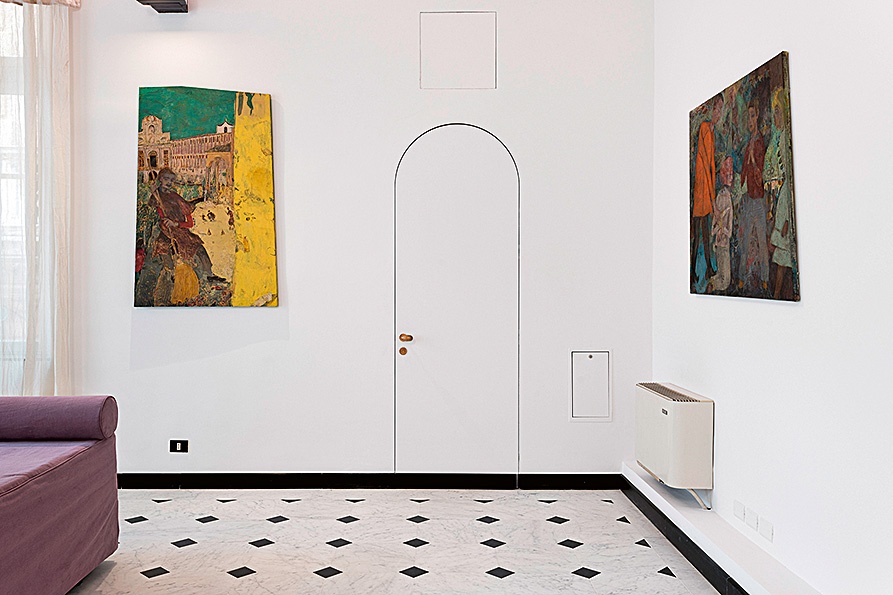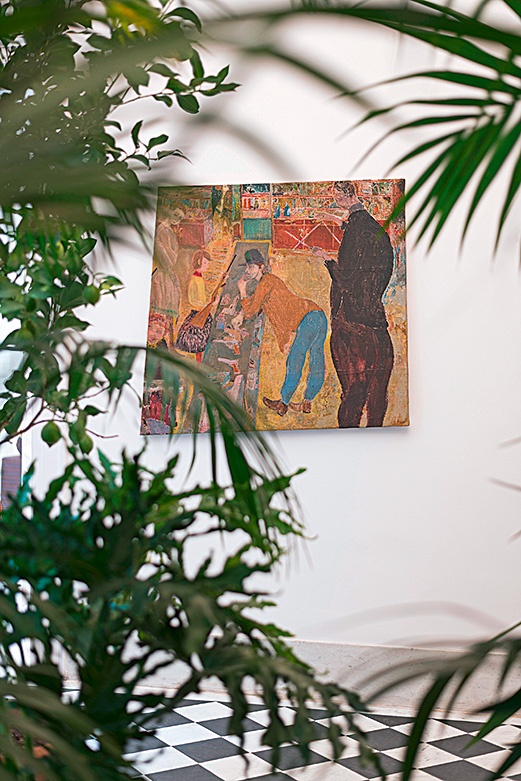ESCAPES OF A PETITE NIGHTMARER Hans‐Christian Dany on Kai Althoff at nervi delle volpi, Genoa

„Kai Althoff: di costole“, nervi delle volpi, Genua, 2024
I happen to know a burglar in Genoa. I encouraged him to see the Kai Althoff show at Galerie Neu’s local pop-up space. He went and sent me an excited message: “Never seen paintings like that before! A real find! Grazie mille!” Meanwhile, the palazzo on whose upper floor the recently inaugurated exhibition space known as nervi delle volpi is located was not new to him – he had scoped out the building a few months earlier. During that first inspection, though, everything had still been under construction.
Let me not be misunderstood: my friend likes to pick locks, but he rarely steals, because he needs very little. Roaming the rooms behind locked doors, to him, is a playful way to feel the kick of the illicit. Kai Althoff, too, formerly displayed a marked penchant for transgression. At one party in the early 2000s, he even claimed to have “taken a dump” in his own exhibition. Around the same time, he wrote a note for a show he had together with Armin Krämer at Kunstverein Braunschweig in 2002 in which he mentioned a conflict with himself: “A struggle flares up within me, because in reality I would like to mortify what these two (the two ‘daredevils’) represent.” [1]
Twenty-two years later, the figure that now emerges in Genoa is not so much the conflicted daredevil Althoff as rather a painter who says yes to where his brush leads him. True, Althoff’s art has always been an affirmation of nascent visibility. When the time came to exhibit, though, the artist has often thrown a wrench in the works of his own yes. That wrench was constructive in his 2012 “Letter of Refusal” to the director of dOCUMENTA (13), which turned the handwritten no into an exhibition object with its own aura. It seemed contorted in a complicated way in the idiosyncratically installed retrospective at the Museum of Modern Art in New York (2016), where some of the works remained in their crates; the press romanticized this asseveration of artistic self-determination as a scandalous offense. At a venue where others, primarily the curators, are normally in command of the selection and hanging, Althoff took the reins and insisted: this way or no way!
Still, Althoff’s quest for integrity has also said yes time and again: most resoundingly so in Häuptling klapperndes Geschirr (Chief Rattling Dishes, 2018/19). In its early days, Tramps, the venue in New York that hosted this show, was still shrouded in hip opacity; in reality, it was a foster child of Galerie Michael Werner in disguise. The enterprise set up above an Asian food market in Chinatown, in a shopping arcade that had seen better days. Due to the two-story building’s location under a subway overpass, the champagne coupes stacked up in pyramids on the Tramps bar rattled every few minutes. In the gallery, meanwhile, visitors ambled on a soft and noise-swallowing floor laid with flattened cardboard moving boxes. The ink drawings hanging on the walls seemed to show Althoff in creative engagement with Chinese calligraphy. “That nothing was ever a reality, as no reality ever exists,” the press release – to judge by its tone, written by Althoff himself – explained.

„Kai Althoff: di costole“, nervi delle volpi, Genua, 2024
The show in Genoa presumably has different references. Yet here, too, the noise of the world of everyday life is kept out by the curtains in front of the closed street-facing windows as a reality besides reality unfolds in the interior. The surfaces of the pictures are softly matte and possessed of a dull depth. The contours of figures emerge out of fields painted in the colors of another time. Yellow and brown repeatedly retreat into darkness. Hues of green prove shifty. No brushstroke looks mechanical, nothing smells of production. Standing before the pictures, I think of Pierre Bonnard, sometimes also of Édouard Vuillard. Many of the paintings are held by shaped stretcher frames that avoid the straightforward rectangle. Here and there a warped frame is crisscrossed by sutures, like scars on an injured body. If the first impression is that this is simply pictures hanging on the walls, such asceticism soon reveals itself to be equivocal. The installation aspect is now less obvious than in earlier Althoff exhibitions. With heavy doorframes, ornamented floors, and meticulously selected furnishings, it initially camouflages itself as a setting from a different era – but then the plants and seating furniture coalesce into a larger whole curated by the artist. The paintings dovetail so tightly with the interior that I wonder whether it is all a fiction in three dimensions, titled “nervi delle volpi.” Now, almost any better exhibition begins with a speculative proposition; but the “nerves of the foxes” read like a novella, one about a possible exhibition as a game. Then again, “game” is a vague concept, and labeling Kai Althoff a gambler would be a misconception: he leaves little to chance. Rather than betting on where the ball will fall in the wheel, he prefers to play games in which he holds the joystick firmly in hand. In the catalogue brochure accompanying the show in Genoa, Giulia Ruberti writes that this is about games of the sort that children play, but also about those “dangerous and perverse” games that are especially popular in the transitional stage before adolescence. She goes on to enumerate more or less erotic practices in which people are haunted by “confused drives.” In the exhibition, the element that most strongly gives off that sort of vibe is the toilet. It is set behind a door embedded in the wall, right next to a cityscape whose depth effect forcefully attracts the eye. Everyone can see who needs to use it. As though this walk of shame were not bad enough, the cramped room is completely tiled with mirrors. Visitors voiding their bladders or bowels are virtually compelled to contemplate their own sex. The confrontation with the body parts to which shame attaches corresponds to a half-open bar cabinet in the rearmost of the three exhibition rooms, whose interior is similarly mirror-clad. What goes in at the top comes out at the bottom.
There was a prologue to the extensive renovations after the gallery moved in: Kai Althoff has been represented by Galerie Neu since the second half of the 1990s but has not exhibited in its rooms for over 20 years. After all that time, they probably held little hope of luring him back to their home in a no-frills prefabricated building in Berlin-Mitte for another show. Then, two years ago, one of the gallery’s two owners spotted the palazzo in Genoa and asked Althoff whether he wanted to install an exhibition there. The artist was flown in and, so I am told, was excited by the idea but demanded a number of alterations. (This makes me think for a moment of another house, one from which my friend the burglar once sent me cellphone shots after I had tipped him off that he should go see it from inside: Villa Jako in Hamburg. Karl Lagerfeld had acquired the building, previously inhabited by a family of ship captains, in memory of his dead lover Jacques de Bascher, but never lived there; he contented himself with refurbishing the property on the hillside looking out over the Elbe River, raising its value, and then reselling it at a markup.)

Kai Althoff, „Untitled“, 2024
Not only was the palazzo in Genoa renovated and fitted out in accordance with Althoff’s ideas; all ninety guests attending the post-opening dinner at a restaurant sat where the artist himself had placed them. I wondered why I in particular was supposed to talk to the lady who was currently designing a subway line in Shanghai. I could not boast of a similarly brilliant project, so I tried to explain to her why Althoff’s exhibition reminded me of Wiener Blut’s perfume “Unheimlich.” “According to Freud, the uncanny is at once familiar and strange to us,” the advertising copy reads. “The scent is an attempt to capture this quality – dark, clean, impure, innocent, erotic, exciting, and fascinating – it fits into no conventional category.” Although I had committed a faux pas by chatting, however indirectly, about the exhibition over dinner, the subway planner immediately picked up on the metaphorical connection I was drawing between the perfume prose and Althoff’s art. Yes, she said, that was spot-on in many ways. But do the artist and the perfumer really tread similar paths? Alexander Lauber, the maker of the niche scent, starts by expending considerable effort on figuring out the secret formulas from the era of the imperial and royal monarchy. He then filters the fragrances through concepts of modernity – in this instance, through Sigmund Freud’s interpretation of the uncanny – in a voyage across history to arrive at a perfume that meets the present moment. In Althoff’s case, by contrast, I can actually imagine that he excavates the subjects of his pictures from the depths of his mental archive. It seems like he has been carrying his pictures around with himself since forever, manifestly living in a cozily intimate relationship with his nightmares. And what makes Althoff contemporary is precisely that, in adopting a distorted perspective, he turns his back on the present. One picture shows a girl in a gun shop, weighing a shotgun in her hands. The salesman stands behind the counter, and behind him the dark silhouette of an outsize man. In another painting, a woman kneels on the floor; a man cuts the strings tying her hands behind her back. Where the violence is less obvious, the faces are clouded over. All pictures are suffused with a pensive, dreamy, sometimes oppressive atmosphere.
“That we are a bit older than just of today has always struck me as obvious,” the subway designer quotes Botho Strauß. “But is that why we now react so strongly to Althoff’s pictures?” They depict extraterrestrials whose cruelty feels familiar. The collector on the other side of the table shoots us an indignant look because we are still discussing the exhibition. The lady is totally over the whole thing, presumably because she has already snapped up her painting, though not at a discount; as parties speaking off the record have underscored with evident pleasure, demand has been high.
Considered in athletic terms, the exhibition comes across as a successful coup de main at a difficult time – difficult, too, for the art trade. But it would be a mistake to reduce it to that feat or read the imagery as no more than a retreat into escapist melancholy. At a moment when rapid-fire developments deluge us with snapshot imagery and a slow language like art’s hardly seems like the right tool to keep up, Althoff’s insistence on grappling with questions he himself has raised beckons as a possibility. Not because it proposes an escape into beauty but because it takes a stand, one that holds up amid increasingly challenging circumstances.
Translation: Gerrit Jackson
„Kai Althoff: di costole“, nervi delle volpi, Genua, 5. Oktober bis 14. Dezember 2024.
Hans-Christian Dany lives in Hamburg. He recently published the book Schuld war mein Hobby. Bilanz einer Familie (Edition Nautilus, 2024) and, together with Valérie Knoll, curated the exhibition “Udo is Love. Zeit ist die Sünde – Eine Reise in das unfassbare Leben des Udo Kier” at the Kölnischer Kunstverein (2024).
Image credit: Courtesy of Kai Althoff and nervi delle volpi, Genua, photos Stefan Korte
Note
| [1] | The original German reads: “In mir entsteht ein erster Kampf, denn in Wirklichkeit möchte ich in mir abtöten, was, diese beiden (die ‘Draufgänger’) darstellen.” |

